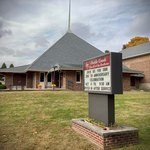Our History
Our 200 Year Plus History!
The Nettle Creek Church of the Brethren has been an integral part of the Nettle Creek area since its inception. Many local families have been connected to the church over the years. Also, several have ancestors buried in its adjacent cemetery.
The First 100 Years (1820-1920)
In 1820, just four years after Indiana attained statehood, early German Baptist Brethren pioneers settled in the Nettle Creek area. Some preachers from south of Richmond, IN (near Boston, IN), from the 4 Mile congregation came to help begin a church in the Nettle Creek area. As pioneers, the early Brethren worked hard to clear land, begin farms, and build homes, which they met in for worship during the first 25 years. In 1845, they built their first brick building on land donated from one of its members, Samuel Eiler. Later more land was donated, from the Stout family, to increase the size of the cemetery. Due to structural problems, the first building had to be replaced by a second brick building in 1875, built nearby on the same property, where it now stands. Since it was brick, it was referred to as the “Brick Meetinghouse,” or the “Brick Church,” located on the road which now bears its name, “Brick Church Road.”
The building was intentionally plain, with no baptistry, stained glass, pulpit, steeple, or many other symbols of churches, due the Brethren understanding of faith. The Brethren instead sat lengthwise with men on one side and women on the other, with a “preacher’s bench” or a row of preachers in the front, on ground level, because the preachers were not to be elevated above the congregation. They also refrained from using organs, pianos or musical instruments, but instead sang each line a cappella in German. Then after kneeling on the floor and reciting the Lord’s prayer, the Scripture would be read, and one main preacher would preach, followed by two or three other preachers who would add to it. After closing prayer, the congregation would eat dinner and fellowship together before heading back to their homes on their horses and buggies in order to be home by dark.
The early Brethren dressed plain, with men wearing beards with no mustaches and plain clothes with no neckties. The women wore plain dresses with prayer coverings on their heads. The focus of the early Brethren was obedience to the New Testament, especially the commands of Jesus. They baptized new believers three times forward in the name of the Father, the Son and the Holy Spirit. They partook of communion on a Saturday evening, often gathering with other Brethren from nearby congregations, to wash each other’s feet, eat a simple fellowship meal and take bread and cup.
The Second 100 Years (1920-2020)
The second hundred years was a century of change. By 1908, the denomination changed its name from the German Baptist Brethren to the Church of the Brethren. The dress requirements began to loosen and change as the men no longer wore the beards and eventually wore neckties. The ladies continued to wear the prayer veil until mid-century, when they no longer wore them for worship. The century would also see musical accompaniment with piano and organ and even guitars and drums currently in use.
The national Brethren made significant impact on the world during this past century, particularly in its efforts to bring peace and service to the world. The Brethren, along with the Quakers and Mennonites helped attain conscientious objector status for young male pacifists. They developed models of alternative service, including Brethren Volunteer Service, where Brethren could serve for two years in a non-military avenue. Also, in the 1940s, Hoosier Brethren, Dan West, started Heifer Project International, as a way to help feed those in need around the world, along with starting the peace studies program at Manchester College. The Brethren also became very active in serving those who had suffered natural disasters, through Brethren Disaster Response.
Locally, in 1955, the three churches officially separated, each adding paid, professional ministers, pulpits, stained glass, new or remodeled sanctuaries with baptistries, and adding parsonages for the pastors and their families to live. The 1950s and 1960s were a time of change, growth and expansion for the Nettle Creek Church, which dedicated its new sanctuary in 1968. The active membership of the Nettle Creek, Locust Grove and White Branch churches peaked in the 1970s and 1980s as many area families were involved in these three churches.
By the end of the 1990s, all three churches had begun to decline numerically, but these past 20 years have also seen renewed efforts to serve the community and continue in vibrant worship, including the use of technology. From 2014-2019, Nettle Creek and White Branch combined efforts to produce the “Good News Radio Program,” featuring the messages from the two churches. Currently, Nettle Creek and White Branch have their Sunday services available on Facebook Live. The Locust Grove Church typically hosts a community picnic and revival services each fall. The Nettle Creek Church has been a SAG stop for the annual Richmond BikeTourFest. The White Branch Church hosts a community Chicken N Dumplings supper each spring. Like the surrounding community, which these churches have been an integral part of for the past 200 years, they are “mighty, small churches.” The Nettle Creek Church of the Brethren celebrated 200 years in the midst of the COVID-19 pandemic, Sunday October 11, 2020.
Fast Facts:
Name: Nettle Creek Church of the Brethren (formerly German Baptist Brethren)
Nickname: Brick Church (for its Brick Meetinghouses)
Organized as a church: 1820
First Building Erected: 1845
Current Building Erected: 1875
Current Sanctuary Added and Dedicated: 1968
Birthed sister churches: White Branch Church of the Brethren (1858) and Locust Grove Church of the Brethren (1859)
Started adjacent Brick Cemetery
Hosted national German Baptist Brethren Annal Conference: 1864





































